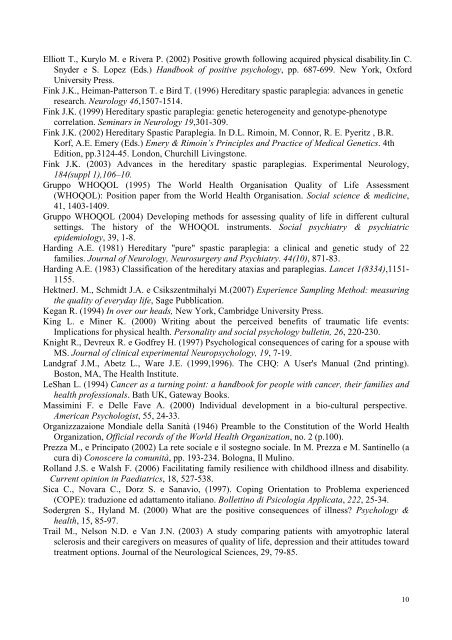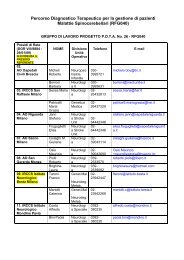qualita' della vita e promozione del benessere nella paraparesi ...
qualita' della vita e promozione del benessere nella paraparesi ...
qualita' della vita e promozione del benessere nella paraparesi ...
You also want an ePaper? Increase the reach of your titles
YUMPU automatically turns print PDFs into web optimized ePapers that Google loves.
Elliott T., Kurylo M. e Rivera P. (2002) Positive growth following acquired physical disability.Iin C.<br />
Snyder e S. Lopez (Eds.) Handbook of positive psychology, pp. 687-699. New York, Oxford<br />
University Press.<br />
Fink J.K., Heiman-Patterson T. e Bird T. (1996) Hereditary spastic paraplegia: advances in genetic<br />
research. Neurology 46,1507-1514.<br />
Fink J.K. (1999) Hereditary spastic paraplegia: genetic heterogeneity and genotype-phenotype<br />
correlation. Seminars in Neurology 19,301-309.<br />
Fink J.K. (2002) Hereditary Spastic Paraplegia. In D.L. Rimoin, M. Connor, R. E. Pyeritz , B.R.<br />
Korf, A.E. Emery (Eds.) Emery & Rimoin’s Principles and Practice of Medical Genetics. 4th<br />
Edition, pp.3124-45. London, Churchill Livingstone.<br />
Fink J.K. (2003) Advances in the hereditary spastic paraplegias. Experimental Neurology,<br />
184(suppl 1),106–10.<br />
Gruppo WHOQOL (1995) The World Health Organisation Quality of Life Assessment<br />
(WHOQOL): Position paper from the World Health Organisation. Social science & medicine,<br />
41, 1403-1409.<br />
Gruppo WHOQOL (2004) Developing methods for assessing quality of life in different cultural<br />
settings. The history of the WHOQOL instruments. Social psychiatry & psychiatric<br />
epidemiology, 39, 1-8.<br />
Harding A.E. (1981) Hereditary "pure" spastic paraplegia: a clinical and genetic study of 22<br />
families. Journal of Neurology, Neurosurgery and Psychiatry. 44(10), 871-83.<br />
Harding A.E. (1983) Classification of the hereditary ataxias and paraplegias. Lancet 1(8334),1151-<br />
1155.<br />
HektnerJ. M., Schmidt J.A. e Csikszentmihalyi M.(2007) Experience Sampling Method: measuring<br />
the quality of everyday life, Sage Pubblication.<br />
Kegan R. (1994) In over our heads, New York, Cambridge University Press.<br />
King L. e Miner K. (2000) Writing about the perceived benefits of traumatic life events:<br />
Implications for physical health. Personality and social psychology bulletin, 26, 220-230.<br />
Knight R., Devreux R. e Godfrey H. (1997) Psychological consequences of caring for a spouse with<br />
MS. Journal of clinical experimental Neuropsychology, 19, 7-19.<br />
Landgraf J.M., Abetz L., Ware J.E. (1999,1996). The CHQ: A User's Manual (2nd printing).<br />
Boston, MA, The Health Institute.<br />
LeShan L. (1994) Cancer as a turning point: a handbook for people with cancer, their families and<br />
health professionals. Bath UK, Gateway Books.<br />
Massimini F. e Delle Fave A. (2000) Individual development in a bio-cultural perspective.<br />
American Psychologist, 55, 24-33.<br />
Organizzazaione Mondiale <strong><strong>del</strong>la</strong> Sanità (1946) Preamble to the Constitution of the World Health<br />
Organization, Official records of the World Health Organization, no. 2 (p.100).<br />
Prezza M., e Principato (2002) La rete sociale e il sostegno sociale. In M. Prezza e M. Santinello (a<br />
cura di) Conoscere la comunità, pp. 193-234. Bologna, Il Mulino.<br />
Rolland J.S. e Walsh F. (2006) Facilitating family resilience with childhood illness and disability.<br />
Current opinion in Paediatrics, 18, 527-538.<br />
Sica C., Novara C., Dorz S. e Sanavio, (1997). Coping Orientation to Problema experienced<br />
(COPE): traduzione ed adattamento italiano. Bollettino di Psicologia Applicata, 222, 25-34.<br />
Sodergren S., Hyland M. (2000) What are the positive consequences of illness? Psychology &<br />
health, 15, 85-97.<br />
Trail M., Nelson N.D. e Van J.N. (2003) A study comparing patients with amyotrophic lateral<br />
sclerosis and their caregivers on measures of quality of life, depression and their attitudes toward<br />
treatment options. Journal of the Neurological Sciences, 29, 79-85.<br />
10



